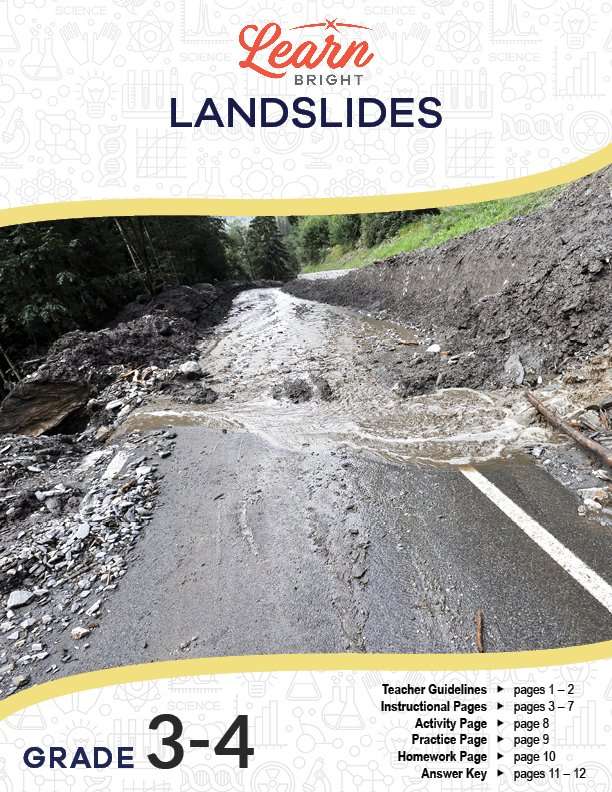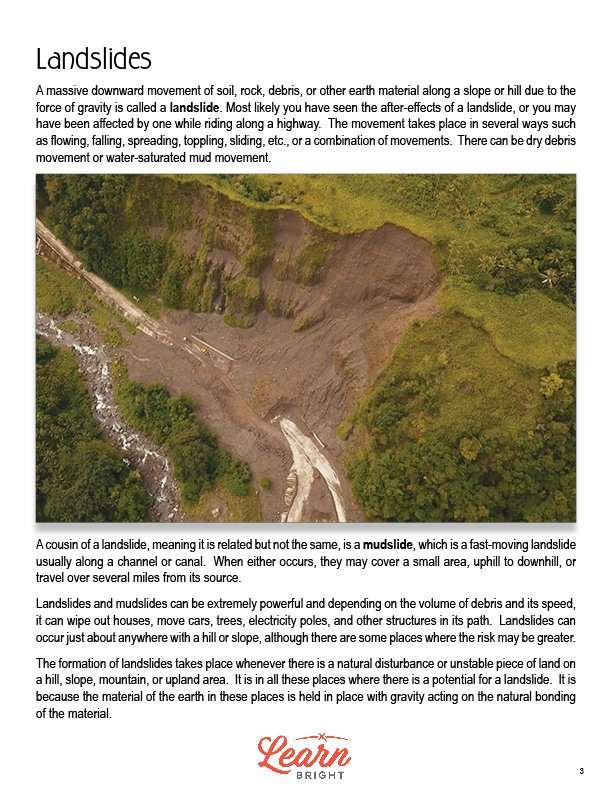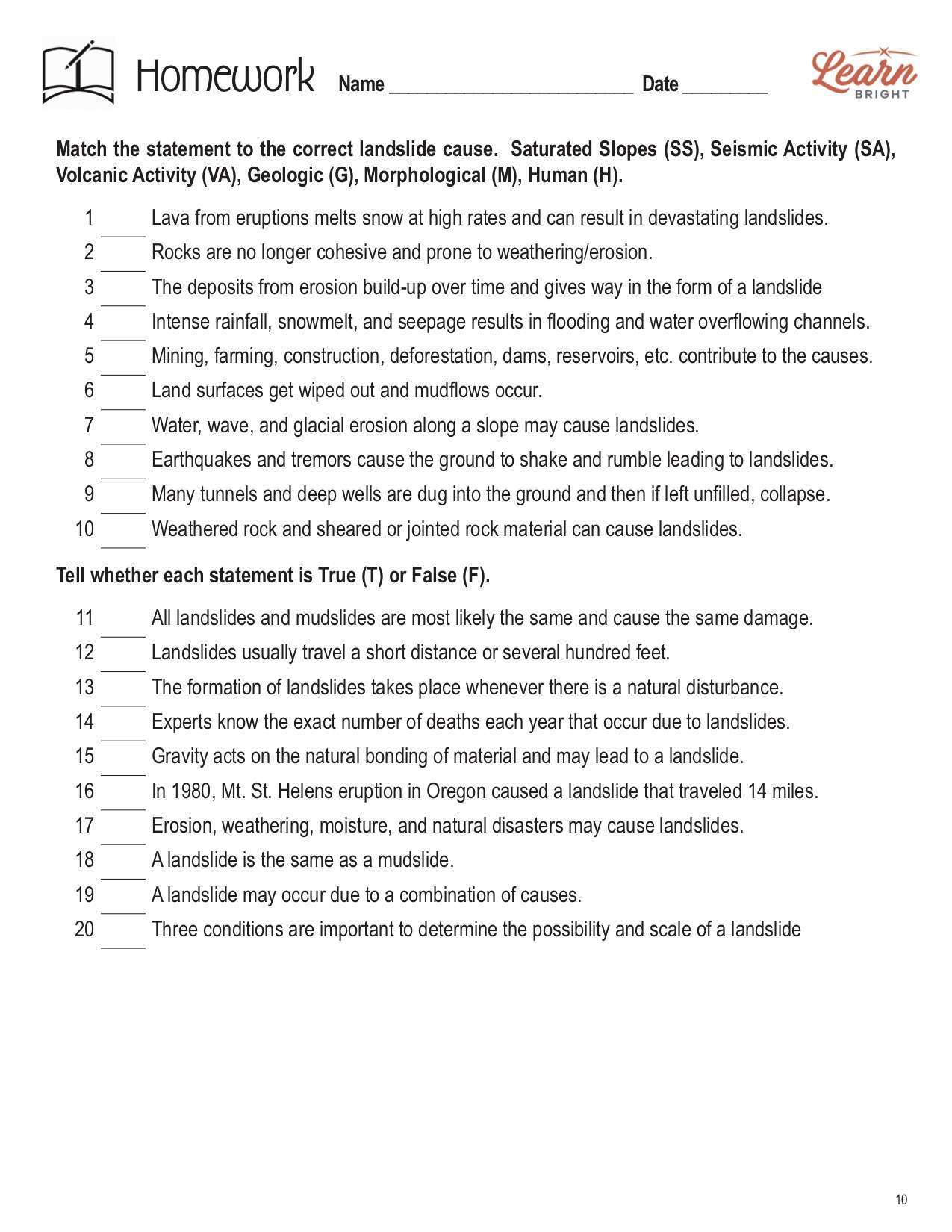Description
What our Landslides lesson plan includes
Lesson Objectives and Overview: Landslides teaches students about the different types of landslides. Students will discover a number of causes, effects, and prevention methods for landslides. They will learn how to identify different types based on their traits, and will also discuss some notable landslide events in history. This lesson is for students in 3rd grade and 4th grade.
Classroom Procedure
Every lesson plan provides you with a classroom procedure page that outlines a step-by-step guide to follow. You do not have to follow the guide exactly. The guide helps you organize the lesson and details when to hand out worksheets. It also lists information in the yellow box that you might find useful. You will find the lesson objectives, state standards, and number of class sessions the lesson should take to complete in this area. In addition, it describes the supplies you will need as well as what and how you need to prepare beforehand. For the Landslides lesson plan, the only supplies you will need, in addition to copies of the worksheets, are poster paper, colored pencils or markers, or other supplies you think students could use for the posters.
Options for Lesson
There are several suggestions in the “Options for Lesson” section that you could incorporate into the lesson if you want to extend it or have extra time. Students could create quizzes based on the information they found as they researched their landslide. You can collect all the quizzes and create a single test out of them to distribute to the class. Another option is to get soil, sand, rocks, and other debris and collect various containers and water to simulate different types of landslides. Use YouTube videos to show students examples of real landslides and their effects. One more idea is to invite an engineer to talk to the class about ways to prevent landslides.
Teacher Notes
The teacher notes page gives you a little extra guidance or information on what to expect from the lesson plan. It mentions that you could use this lesson in conjunction with others that relate to natural disasters, flooding, and other similar topics. The blank lines are available for you to write out any thoughts or ideas that come to you as you review and prepare this lesson.
LANDSLIDES LESSON PLAN CONTENT PAGES
The Landslides lesson plan includes five pages of content. Students first learn what exactly a landslide is and why they occur in the first place. A landslide occurs when gravity causes a massive downward movement of soil, rock, debris, and other earth material along a slope or hill. Some students may have experienced one themselves, or at least seen its aftermath.
These movements take place in different ways—flowing, falling, spreading, toppling, and sliding. It’s possible for one landslide to move debris in more than one way at the same time. A mudslide, similar but not exactly the same, involves fast-moving mud, usually along a channel or canal. Either of these can cover small areas or travel several miles from its source.
Both disasters can be extremely powerful. Depending on the volume of debris and the speed at which it moves, it can wipe out houses, move cars and trees, and take out electricity poles and other structures. Landslides can occur almost anywhere that there is a hill or sloping surface. However, some places pose a greater risk than others.
A landslide forms whenever there is a natural disturbance or unstable piece of land on a hill, slope, mountain, or upland area. The reason these areas can potentially suffer landslides is that gravity acts on the natural bonding of the material of the earth in these areas. It is the only force keeping it there. If you placed a pile of dirt on the side of a hill, it will likely stay put because gravity will keep it there. However, if that area becomes unstable, gravity will also be the force that causes the soil to roll down the hill.
Conditions
The earth material can lose its bonding through erosion, weathering, too much moisture, or other causes. Natural disasters like earthquakes, volcanic activity, floods, and tremors can likewise affect an area’s stability. When this happens, the overlying rock or debris will give way, and gravity will pull the earth downhill. In other words, anything that can potentially break up the earth can cause a landslide, even a bulldozer moving soil from one place to another.
There are three conditions that determine the possibility and scale of a landslide: slope, water, and earth movement. A slope can vary in how steep it is. The steeper a slope, the more destruction it can cause since debris can flow faster down steeper planes. The presence of water will affect the flow of debris as well. More water yields faster and farther debris movement. It even grows more destructive as the eroding force of pressure and power increases as it flows.
Earth movements are disruptions within mountains or hills. Normally, a mountain will remain in place if nothing disturbs it. However, earthquakes, tremors, and volcanic eruptions can shake the land and disturb the bedrock bonding. This often leads to landslides or mudslides.
Causes of Landslides
As the lesson discussed earlier, several factors can cause a landslide. Different areas in the world are prone to different causes. For example, if you live in an area that doesn’t have any volcanoes, it is highly unlikely a landslide would occur because of volcanic activity. The content pages outline and explain six causes.
Saturated slopes are areas where there is intense rainfall, snowmelt, and seepage that saturates the land. These places often experience floods. Channels overflow with water and mudflows wipe out the land surfaces. Seismic activity, earthquakes, and tremors cause the ground to shake in certain places in the world, and the vibrations weaken the bonding of rock.
Similarly, volcanic activity can cause a landslide as well. Lava from volcanic eruptions melts snow at high rates. The combination of melted snow, debris, ash, and soils can flow very quickly along a hill or slope. Another cause is geological, or related to rocks. Generally, cohesive rock often holds itself in place and is less prone to weathering and movement. However, weathered rock and sheared or jointed rock material can cause landslides.
Morphological causes involve different forms of erosion, such as water, waves, glacial movements, and more. These movements along a slope can cause landslides, mudslides, and other flows. The deposits from erosion build up over time and eventually give way in the form of a landslide.
Finally, human activity—mining, farming, construction, deforestation, irrigation, dam building, and reservoirs—can likewise contribute to landslides. For instance, miners have to dig many tunnels and deep wells into the ground. If they remain unfilled, air and water can get in and eventually cause a landslide to occur.
Types and Effects of Landslides
There are also several types of landslides that scientists have classified according to their movements and the earth material involved. These are slide, topple, fall, flow, and torrent. There are two kinds of slide: transitional and rotational. Transitional means the earth mass remains in place after it slides downhill. Rotational means the earth material rotates as it moves. The slide is also considered the slump.
Topple landslides mean the mass of earth rotates forward on a pivot. There is often a tilt without collapse, and these landslides usually happened because of cracks or fractures in the bedrock. Falls usually take place along steep slopes or cliffs. Gravity disturbs the earth material after large blocks and boulders break off.
Flows are also divided into a few types. Debris flow involves the rapid downhill movement of loose earth, often with water. Debris avalanche is similar, but has a much faster flow. Mudflows or mudslides happen when fine silt, sand, and clay material, saturated with water, flow very rapidly. Creeps are very slow but can still bend electric poles and roads slightly. The last flow type, earth flow, happens when finer material leaves a depression bowl when washed away.
Torrent landslides occur when debris and water discharge sporadically along low-lying channels and between highlands. Regardless of the type, the effects of a landslide can range from minor to devastating. In the U.S. alone, 25 to 50 people die each year from landslides. Worldwide, there were over 32,000 landslides that caused 2,600 deaths between the years 2004 and 2010. Many believe this death toll is underestimated.
Students will learn that landslides can greatly affect property, environment, economy, and more. The volcanic eruption of Mount St. Helens in Washington state caused great property damage. The landslide traveled 14 miles and wiped out bridges, roads, and buildings. A landslide in 2018 in California killed 17 people and destroyed hundreds of homes in its path.
LANDSLIDES LESSON PLAN WORKSHEETS
The Landslides lesson plan includes three worksheets: an activity worksheet, a practice worksheet, and a homework assignment. These exercises will help reinforces students’ grasp of the lesson content and allow them to demonstrate what they learned. The guide on the classroom procedure page outlines when to hand out each page to the students throughout the lesson.
LANDSLIDE TYPE POSTER ACTIVITY
The worksheet states that students will work with partners for the activity, but you can have them work alone or in groups if you prefer. The worksheet contains instructions for creating a poster. Students will work with their partners to create a poster that displays information on the landslide you assign them. The poster should include step-by-step drawings, relevant vocabulary, and a catchy title. You will grade the posters at the end.
MATCH THE TERMS PRACTICE WORKSHEET
There are two sections of the practice worksheet. For the first section, students will match definitions to the correct terms. There are a total of 15 questions and terms to match. The second section requires students to fill in the blanks. There are five total questions in this section.
LANDSLIDES HOMEWORK ASSIGNMENT
Similar to the practice worksheet, the homework assignment is divided into two sections. The first section requires students to match statements to the type of landslide cause to which it relates. This section contains 10 questions total. For the second section, students will decide whether the statements are true (T) or false (F). There are 10 questions in this section as well.
Worksheet Answer Keys
The last two pages are answer keys for the practice worksheet and homework assignment. The correct answers are in red to make it easier for you to compare them to your students’ responses. Given the nature of the questions on both assignments, students’ answers should mirror those on the answer keys. If you choose to administer the lesson pages to your students via PDF, you will need to save a new file that omits these pages. Otherwise, you can simply print out the applicable pages and keep these as reference for yourself when grading assignments.









